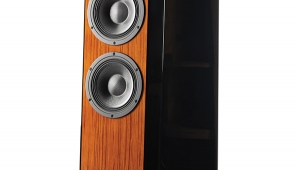| Columns Retired Columns & Blogs |
Snell B minor loudspeaker Associated Equipment
Sidebar 2: Associated Equipment
Footnote 1: See TJN's comments on the KSA-250 in his January review of the Krell KSA-300S (Vol.17 No.1, p.96).
A variety of associated equipment was used in this review. For most of the listening, I used the Krell KSA-250—the amplifier that had proven so successful with the Type B. Tom Norton has written about how the KSA-250 tends to be lean in the mid to upper bass, which could offset the audibility of any midbass peak (footnote 1). The other amplifier that I found to work well with the B, the Bryston 4B NRB, was not available. I also used a Mark Levinson No.27.5, the newest Classé 15, and the Woodside M-50 tube monoblocks. I included the Woodside to determine if an amplifier with higher output impedance (tube amplifiers generally have much higher output impedances than solid-state units) would give a more elevated bass response, as Voecks had suggested in his two "Manufacturer's Comments" on Stereophile's Type B reviews (footnote 6).
Unfortunately, I didn't have the Bs in the room at the same time, so any comparisons are based on similar recordings played at the same level over the B minors, matched at the same distance from the speaker by a Radio Shack spl meter. Comparison loudspeakers on hand included Quad ESL-63 USA Monitors, Chario Academy Ones, Totem Acoustic Ones, and Snell A/III Improveds. I used a Muse Model 18 subwoofer to assess the deep bass. The Quads' and the Snell A/IIIs' midrange/tweeter sections were driven by the Mark Levinson No.27.5, the Class;ae 15, or the Woodside M-50s via parallel runs of Sumiko's OCOS speaker cables, always used in a bi-wiring mode. The A/IIIs' woofer sections were driven by the Krell KSA-250 via HF10C Levinson speaker cables.
Source material included LPs, CDs, and FM stereo broadcasts. LPs were played on a Linn LP12 Lingo turntable with an Ittok tonearm and a Spectral Reference moving-coil cartridge. CDs were played on a Krell MD-1 CD turntable connected to a Krell SBP-32X D/A converter. FM music was obtained from Day-Sequerra FM Reference and Audiolab 8000T stereo tuners. Phono preamplification was provided by a Classé Six Mk.II or a tubed Woodside SC-26. Analog interconnects included AudioQuest Live Wire Topaz and Krell Cogelco.—Larry Greenhill
Footnote 1: See TJN's comments on the KSA-250 in his January review of the Krell KSA-300S (Vol.17 No.1, p.96).
Footnote 2: Kevin Voecks, in his "Manufacturers' Comments" letters (Vol.15 Nos.2 & 6), reminded readers that the Type B was designed to be used with low-impedance amplifiers. If the loop resistance of the speaker cable and amplifier output stage impedance were greater than 0.1 ohm, "the frequency response [of the B] will rise dramatically, the speaker will 'ring' at low frequencies, and the filter network will not operate at its intended frequency and slope." Voecks calculated that the specified 2.5 ohm output impedance of RH's amplifier, a VTL 225, would give the B a bass boost of 3dB. JA demurred, stating that as the VTL's measured output impedance was closer to 1 ohm at 20Hz, this would boost the bass by only 1.3dB. The Woodside's output impedance is only 0.3 ohms, and therefore may not test Voecks's concern that high-impedance amplifier output stages produce anomalous bass performance.
- Log in or register to post comments




































